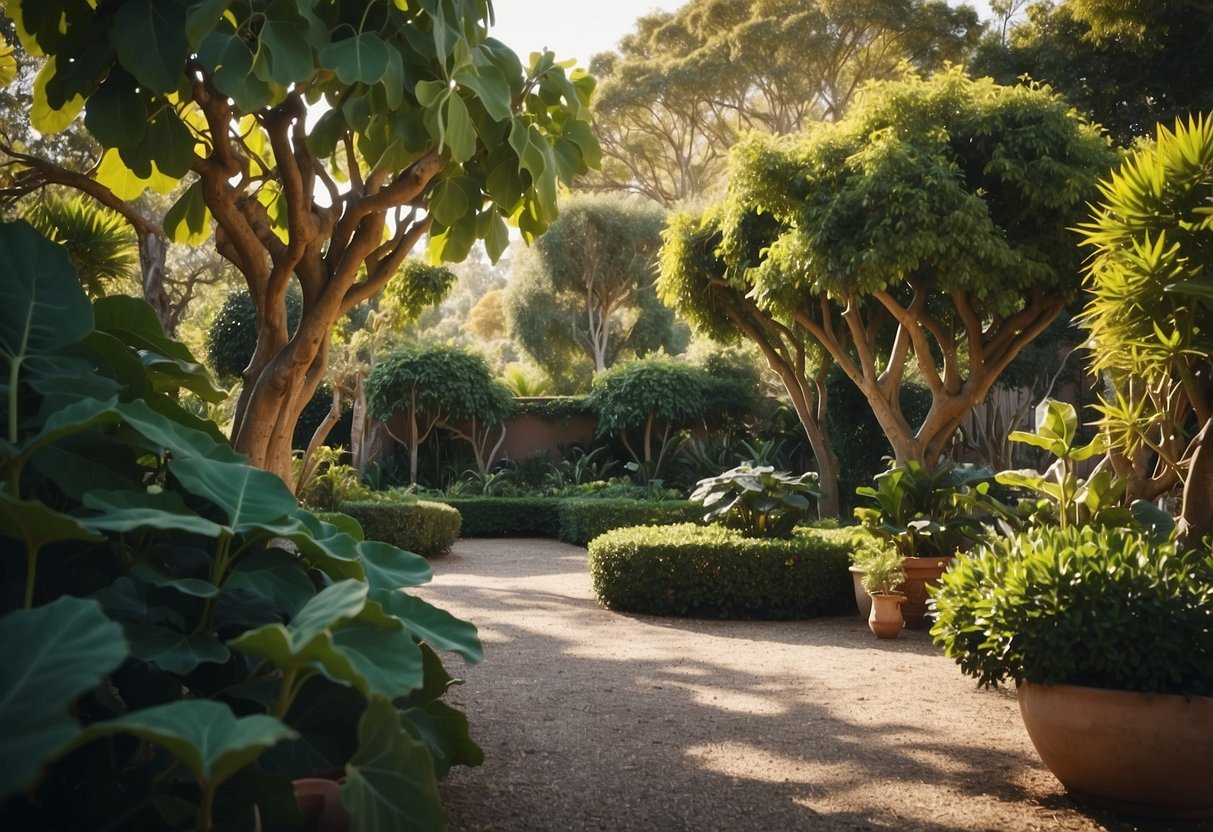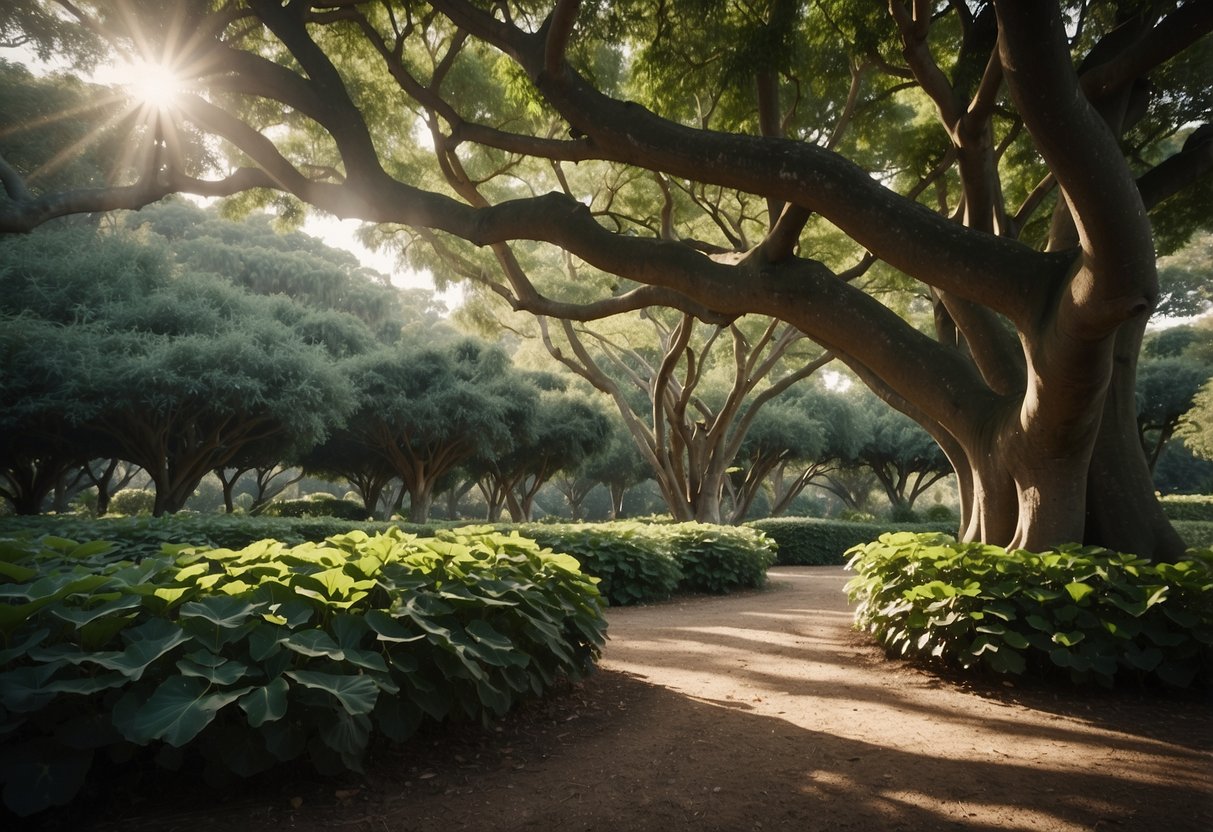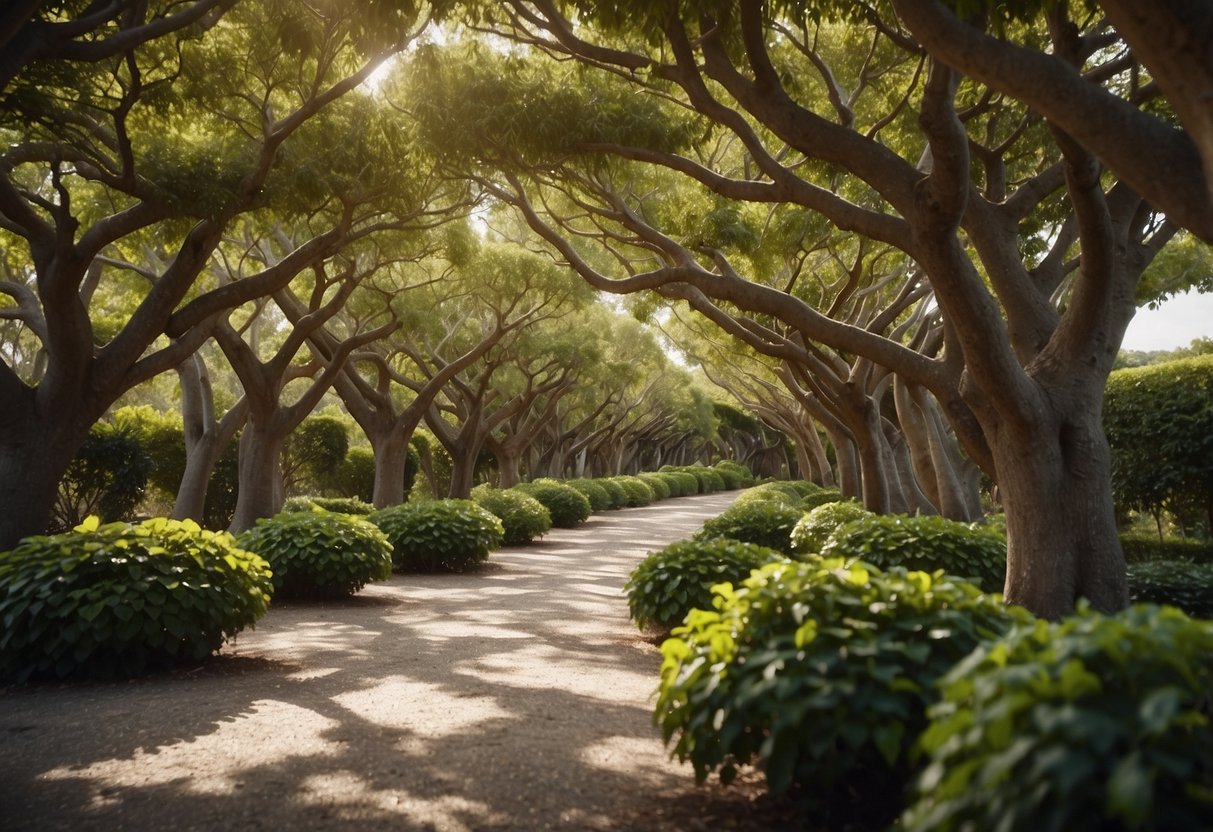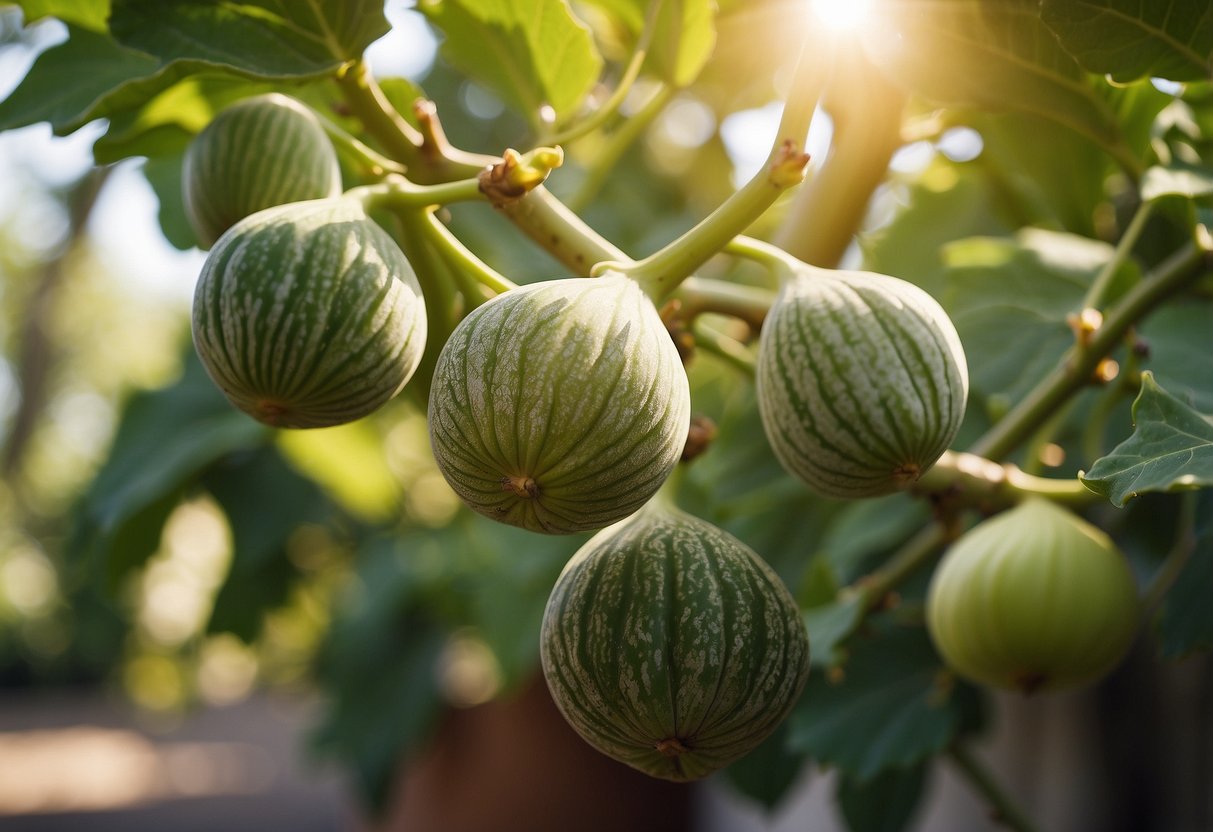Fig Tree Garden Ideas: Transform Your Outdoor Space
Growing a fig tree in your garden can be both a rewarding and enjoyable experience. Fig trees not only provide delicious fruit but also add a touch of beauty to your garden space. Whether you’re a seasoned gardener or a beginner, incorporating fig trees into your garden can be a delightful project.

Wondering how to get started with fig tree gardening? You’ll find plenty of ideas and tips to help you successfully grow and care for these lovely trees. From choosing the right variety to knowing how to care for them year-round, your fig trees will thrive and become a cherished part of your garden.
1) Plant Dwarf Fig Tree Varieties

Dwarf fig trees are perfect for small spaces. They grow no larger than 3 feet tall and wide. This makes them ideal for patios, small gardens, or even indoors in a sunny room.
There are several dwarf fig tree choices. The Brown Turkey Fig grows up to 10 feet tall and has sweet, mild fruit. The Little Ruby is another compact and productive variety, which can be kept even smaller with pruning.
Planting these varieties is simple. Choose a sunny spot and well-draining soil. Water regularly but don’t overdo it. Enjoy your fresh, home-grown figs!
2) Create a fig tree espalier

Creating a fig tree espalier can add beauty and productivity to your garden. First, choose a young fig tree and plant it about six inches from a wall or fence.
Next, train the tree’s branches to grow along horizontal wires or a trellis structure. This helps support the tree and shape it.
Regular pruning is crucial to maintain the espalier shape. Remove any unwanted branches to encourage the growth along the desired pattern.
For more tips and ideas, you can check out creative ideas for espaliering fig trees.
3) Grow figs in large containers

Growing figs in large containers is a great way to enjoy fresh fruit in small spaces. Choose a pot that is at least 10-15 gallons in size.
Use well-draining potting mix to prevent water from pooling. You can also add rocks to the bottom for better drainage.
Large pots allow the fig tree to thrive and produce more fruit. Make sure to water regularly as container trees dry out faster.
4) Incorporate Fig Trees into Mixed Borders

Adding fig trees to a mixed border can create a beautiful and unique garden space. Mixed borders combine perennials, annuals, and shrubs, providing a dynamic and flexible design.
Place fig trees towards the back of the border. This means they will have plenty of space to grow and spread out without overshadowing smaller plants.
You can pair fig trees with low evergreens and colorful shrubs. These will complement the fig tree’s large leaves and provide a dramatic contrast in your garden.
Fig trees need good sunlight and well-drained soil. Make sure to plant them in a spot where they receive at least six hours of sun daily.
For more details on mixed borders, visit Penn State Extension.
5) Design a Mediterranean-inspired fig garden

Start by choosing a sunny spot in your garden. Fig trees need plenty of sunlight to thrive.
Incorporate natural stone features and terracotta pots to give an authentic Mediterranean vibe. You can use pale-colored gravel for paths and create shaded seating areas with rustic tiles.
Plant drought-tolerant herbs like lavender and rosemary around your fig tree for a true Mediterranean feel.
6) Use fig trees as shade providers

Fig trees are fantastic for providing shade in your garden. They have broad leaves that block the sun nicely, offering a cool spot to relax.
You can also plant smaller, shade-tolerant plants under them. This will help create a lovely garden with diverse plants benefiting from the fig tree’s shade.
Additionally, fig tree leaves decompose and enrich the soil. This natural cycle keeps your garden healthy and thriving. Enjoy the shade and the added benefits that fig trees bring to your space.
7) Plant Fig Trees Along Garden Pathways

Planting fig trees along your garden pathways adds a charming touch. The fig trees’ broad leaves create a shady canopy, making your walks more pleasant.
Their fruit attracts birds and can be a delightful surprise on your walks. Fig trees also add a touch of greenery, making your garden feel more vibrant.
By placing fig trees along paths, you can easily access the fruit and enjoy a scenic stroll. For tips on planting, visit Epic Gardening’s guide on fig trees.
8) Combine Figs with Flowering Plants

Combining figs with flowering plants can enhance the beauty of your garden. Marigolds, for example, deter pests and add a splash of color. These flowers are a practical and pretty choice.
Nasturtiums are another great option. They attract aphids away from your fig trees, protecting the fruits.
Consider planting wildflowers. They attract pollinators, helping your fig trees produce more fruit. Plus, they add a natural charm to the garden.
9) Incorporate fig trees in edible gardens

You can add fig trees to your garden to make it more productive. Fig trees are great because they provide delicious fruit and can be grown in containers or directly in the ground.
Choose a sunny spot for your fig tree as they love warmth. Make sure the soil is well-draining and slightly acidic to get the best results.
Prune your fig trees regularly to keep them healthy and encourage fruit production. This will help your garden stay beautiful and fruitful.
10) Grow fig trees against sunny walls

Growing fig trees against sunny walls can help them thrive.
The warmth from the wall protects the tree and encourages growth. It’s ideal to plant the tree about 18 inches away from the wall to let rain reach the roots.
Use vertical paving slabs to contain the roots and support the tree.
Benefits of Growing Fig Trees

Growing fig trees can be very rewarding. Not only do figs taste great, but the trees also have environmental perks.
Nutritional Value of Figs
Figs are a healthy snack. They are packed with fiber, which helps with digestion. Eating figs can also give you a good amount of calcium, which is important for strong bones. They are rich in antioxidants such as vitamin A and vitamin K, helping your body fight off damaging free radicals.
You also get a good dose of potassium from figs, which helps manage blood pressure. They are low in calories, so they fit well into a balanced diet. Fresh figs are delicious in salads, baked goods, or simply eaten on their own. Including them in your diet provides both nutritional benefits and tasty treats.
Environmental Benefits
Fig trees are environmentally friendly. They are hardy and can thrive in various climates, especially in USDA hardiness zones 7-12. Because they can handle drought well, they don’t need a lot of water. This makes them great for areas with water restrictions.
The leaves of fig trees provide shade, which can help cool down your yard. They also improve air quality by absorbing carbon dioxide and releasing oxygen. Fig trees attract beneficial insects like bees, which can help in the pollination of other plants in your garden. Growing fig trees supports local wildlife and contributes to a healthier ecosystem.
If you want more details about fig tree care, check out this helpful guide or learn more about the best fig tree varieties.
Ideal Conditions for Planting Fig Trees

Fig trees thrive in specific conditions to ensure maximum growth and fruit production. Pay attention to the climate they prefer and the type of soil that will help them flourish.
Best Climate for Fig Trees
Fig trees grow best in warm, temperate climates. They prefer areas with long, hot summers and mild winters. If you live in regions like Alabama, Mississippi, South Carolina, or Oklahoma, you’re in luck as these areas provide an ideal environment.
These trees need plenty of sunlight — at least 8 hours a day. If you’re in an area with harsh winters, consider planting your fig tree in a container. This way, you can move it indoors during the colder months to protect it from frost.
Dry weather is more favorable for fig trees since high humidity can cause fungal issues. Make sure the location is not prone to heavy rainfall during the growing season, as this can affect the tree’s health.
Choosing the Right Soil
Fig trees thrive in well-draining soil. The soil should not retain water, as this can lead to root rot. A sandy loam mixture is ideal. You can create this by mixing equal parts of sand, silt, and clay. Adding organic matter like compost can improve soil fertility and drainage.
Keep the soil pH between 6.0 and 6.5. You can test your soil’s pH using a home testing kit from a garden store. If the pH is too low, add lime to raise it. If it’s too high, use sulfur or peat to lower it.
Ensure the planting area has good air circulation. This helps prevent disease and ensures your fig tree gets the nutrients and sunlight it needs to grow strong and healthy.
Care and Maintenance Tips

Caring for fig trees involves watering them properly and pruning to ensure healthy growth. Here’s what you need to know about watering guidelines and pruning techniques.
Watering Guidelines
Proper watering is key to growing healthy fig trees. You should water your fig tree deeply once a week. This helps the roots grow deep and strong. In hot and dry weather, you may need to water more often.
Mulching around the base of the tree can help retain moisture. Use organic materials like straw or wood chips. Mulch also keeps weeds at bay.
Be careful not to overwater. Fig trees hate soggy soil. Make sure the soil drains well to avoid root rot. Test the soil by pushing your finger into it; water if it feels dry about 1-2 inches down.
Pruning Techniques
Pruning fig trees keeps them healthy and productive. Start by removing dead or damaged branches. This opens up the tree and allows better air circulation.
Cut back about one-third of the new growth every year. This encourages more fruit production. Use clean, sharp tools to make cuts just above a node or bud.
For young trees, prune to shape them in the first few years. This helps develop a strong framework. As the tree matures, focus on maintaining its shape and removing any unwanted suckers or excessive growth at the base.
Regular pruning also keeps the tree at a manageable size, making it easier to harvest the figs.







